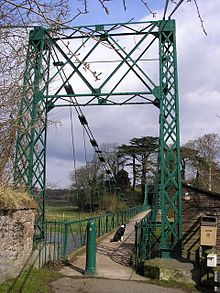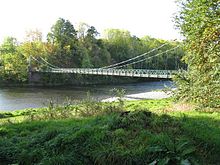- Dryburgh Bridge
-
Dryburgh Bridge refers to two different footbridges erected near Dryburgh Abbey, Borders, Scotland, between the villages of Dryburgh and St. Boswells (part of a ribbon of settlements including Newtown St. Boswells), across the River Tweed. A crossing has existed here for centuries, originally with a ferry service.
Contents
Cable-stayed bridge
Dryburgh Abbey Bridge was a cable-stayed bridge of significant historical interest. It had been commissioned by David Stewart Erskine, 11th Earl of Buchan, an eccentric Scottish aristocrat who later died in Dryburgh. It was 79 metres long. At the time, the cable-stayed type of bridge was undergoing a period of rapid growth in popularity. The Earl opened the completed bridge on August 1, 1817, but in January 1818 it collapsed. After a redesign a replacement was built, but this too collapsed in 1838, by which time the Earl had been dead for several years.
The 1818 collapse, together with that of a slightly shorter bridge across the Saale River in Germany in 1824, caused the reputation of cable-stayed bridges to decline rapidly, and despite a history dating back to the 17th century, the design was almost completely abandoned for over a century, with suspended-deck suspension bridges gaining favour. Later research in the 1930s, and experience with reconstruction after the Second World War, demonstrated that with sound design, cable-stayed bridges are not without advantages, and the first modern design, the Strömsund Bridge in Sweden, was completed in 1955.
Interestingly, very shortly after the 1818 collapse (between 1819 and 1820) another bridge, the Union Bridge, was built further downstream. It was an iron suspended-deck suspension bridge, the longest in the world upon its completion.
Suspended-deck suspension bridge
Dryburgh Suspension Bridge is a suspended-deck suspension bridge. It was erected in 1872 with a gift intended to allow the Dryburgh villagers to worship at the churches in St. Boswells and Newtown St. Boswells. It is a relatively simple design with only one suspended span.
See also
External links
- Tweed bridges
- Dryburgh Abbey Bridge at Structurae
- Collapse of the original bridge
- Entry for the 1818 bridge at Bridgemeister.com
River Tweed, Great Britain Administrative areas Flows into Towns
(upstream to downstream)Tweedsmuir · Peebles · Innerleithen · Walkerburn · Galashiels · Melrose · Newstead · St Boswells · Kelso · Coldstream · Berwick-upon-Tweed
Major tributaries
(upstream to downstream by confluence)Cor Water · Talla Water · Holms Water · Lyne Water · Manor Water · Quair Water · Leithen Water · Caddon Water · Ettrick Water · Yarrow Water · Gala Water · River Leader · River Teviot · River Till · Whiteadder Water
Major bridges
(upstream to downstream)Neidpath Viaduct · Tweed Bridge · Yair Bridge · Leaderfoot Viaduct · Dryburgh Bridge · Mertoun Bridge · Rennie Bridge · Hunter Bridge · Coldstream Bridge · Ladykirk and Norham Bridge · Union Bridge · A1 bridge, River Tweed · Royal Border Bridge · Royal Tweed Bridge · Berwick Bridge
Coordinates: 55°34′48″N 2°39′01″W / 55.5799°N 2.6503°W

This article includes a list of related items that share the same name (or similar names).
If an internal link incorrectly led you here, you may wish to change the link to point directly to the intended article.Categories:- Set indices
- Bridges across the River Tweed
- Bridges in the Scottish Borders
- Bridges completed in 1817
- Bridges completed in 1872
- Suspension bridges in the United Kingdom
- Cable-stayed bridges in the United Kingdom
- Scottish building and structure stubs
- United Kingdom bridge (structure) stubs
Wikimedia Foundation. 2010.


